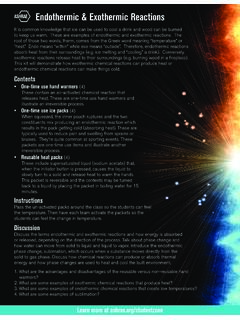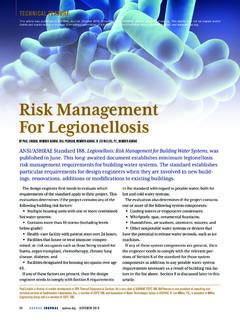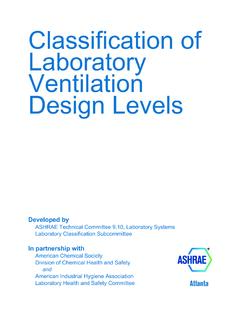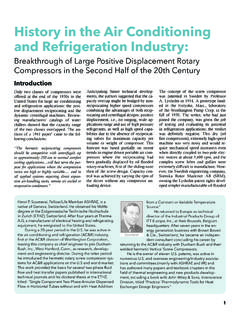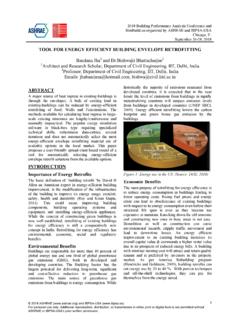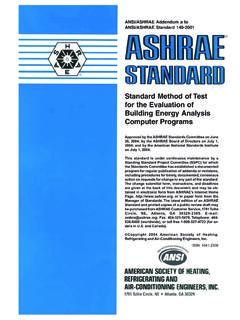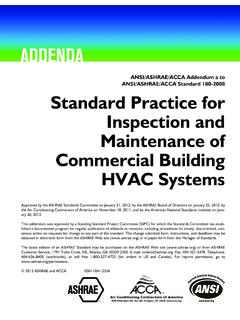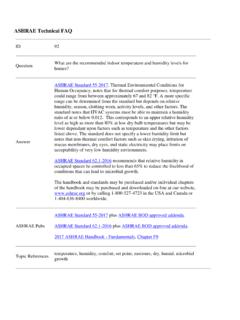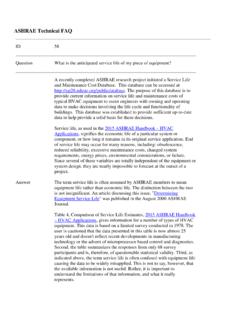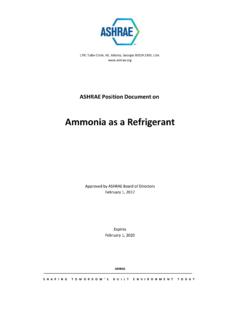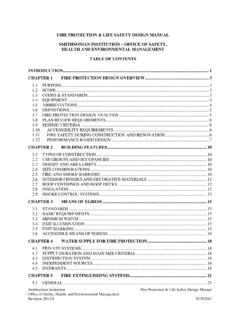Transcription of ASHRAE EPIDEMIC TASK FORCE
1 General Information Building Readiness Intent Building Readiness Team Building Readiness PlanPost- EPIDEMIC Conditions in Place(P-ECiP) P-ECiP: Prior to Occupying P-ECiP: Operational Considerations once Occupied P-ECiP: Ventilation P-ECiP: Filtration P-ECiP: Building Maintenance Program P-ECiP: Systems EPIDEMIC TASKFORCEBUILDING READINESS| Updated4-27-2021 Information in this document is provided as a service to the public. While every effort is made to provide accurate and reliable information, this is advisory, is provided for informational purposes only, and may represent only one person s view. They are not intended and should not be relied upon as official statements of Conditions in Place (ECiP) Systems Evaluation Building Automation Systems (BAS) Ventilation per Code / Design Increased Ventilation above Code Increased Ventilation Control Building and Space Pressure Pre-or Post-Occupancy Flushing Strategy Equivalent Outdoor Air Upgrading and Improving Filtration Filter Droplet Nuclei Efficiency / Particle Size Expectations Energy Savings Considerations Exhaust Air Re-entrainment Energy Recovery Ventilation Systems Operation Considerations UVGI Systems Domestic Water & Plumbing Systems Maintenance Checks Shutdown a Building Temporarily-FAQ system Manual Reopening During EPIDEMIC Conditions in PlaceAdditional Information Acknowledgements References DisclaimerGeneral InformationBuilding Readiness IntentThe following Building Readiness information is meant to provide practical information and checklists for how your building should be operating and how to practically check its operation.
2 Actual conditions at any specific building will vary, and the adjustments that should be made will depend on many factors such as local climate, complexity of systems involved and the use, occupancy and activities that occur in and around your Readiness modes of operation for the building should include the following: EPIDEMIC Operating Conditions in Place (ECiP)oOccupied-at pre- EPIDEMIC capacityoOccupied-at reduced capacityoUnoccupied temporarily, andoOperation during building closure for indefinite periods Post- EPIDEMIC Conditions in Place (P-ECiP)oPrior to Occupying oOperational Considerations once OccupiedGeneral InformationBuilding Readiness Intent Continued Please keep in mind that the mode of the building (ECiP or P-ECiP) is a decision by the Owner that should consider the Federal, State, or Local Government or Health Department designation for the location of this note, that the ASHRAE EPIDEMIC Task FORCE has created a single page document for Core Recommendations for Reducing Airborne Infectious Aerosol Exposure that should be referenced to understand the intent behind all of the guidance.
3 General InformationBuilding Readiness Intent ContinuedThe Building Readiness Guide will provide some of the practical guidance on operating your building systems in these different modes. The suggested mode of operation during the EPIDEMIC periods are detailed in the Buildings Guidance on the ASHRAE Covid-19 Website. Healthcare Residential Healthcare Residential Multifamily Commercial Schools & Universities Laboratory Assemblies of Faith TransportationIn addition, this document will cover specific recommendations from the Building Guidelines such as: system Analysis Ventilation Increased Filtration Flushing Calculations Energy recovery ventilation systems operation considerations Building exhaust air re-entrainmentThis document assumes that the Owner and Facility Operators have completed their EPIDEMIC Preparedness Plan and are ready to shut down, operate, and re-open their building. This can be done in either mode, ECiP or following guide is to provide practical guidance for the Mechanical Systems for those in mind, that for the P-ECiP mode, there are really two phases to consider; Prior to Occupying, and Operational Considerations once Occupied.
4 General InformationBuilding Readiness TeamThe Building Readiness Team could includelicensed and certified professionals and companies that can perform the analysis, testing, design, construction, control programming, balancing, commissioning , maintenance and operation services required to make the adjustments and achieve the performance included in these recommendations. The following are the typical service providers that may be required: commissioning Provider (CxP) engage a CxP that has a recognized certification from ASHRAE (BCxP), ACG (CxA), BCA (CCP), NEBB (BSC and RCx), or others. They should also have completed several Retro- commissioning or New Building commissioning projects in the building type in question. Test and Balance Company (TAB) engage a TAB that has recognized certification from Associated Air Balance Council (AABC), National Balancing Council (NBC), National Environmental Balancing Bureau (NEBB) and Testing Adjusting and Balancing Bureau (TABB) or another certifying body.
5 The TAB agent or service provider should have experience with the building type and systems being evaluated. These certifying bodies require a TAB company operator to have been trained and certified and requires the use of calibrated instruments. Building Automation Systems (BAS) Company the Owner should engage the company currently providing service and support for the control system (s) that are installed in the building. If a new service provider is required, finding a local company that has experience working with and operating the building s existing control systems and preferably certified by the manufacturer to provide services for their equipment. Contractors the Owner should engage, if necessary, the appropriate contractors to install or repair equipment or systems identified by the CxP, TAB, or BAS providers. This could include the following:oGeneral Contractors (GC)oMechanical Contractor (MC)oElectrical Contractor (EC)oSpecialty contractors for fire alarm and smoke control systems and interfaces.
6 Architect and/or Engineer (AE) the Owner should engage a design team for any issues that might require permit drawings. It is preferred that the original Engineer or Architect of Record that was involved with the original construction or the latest renovation or addition to the facility be engaged if possible. Those professionals should be most familiar with the building s current operation. Owner s Facility Staff the Owner should make sure that their facility staff are involved in the process. This allows for the information transfer on how systems might be altered to InformationBuilding Readiness PlanThis is a document that should be created to document the mitigation strategies that the facility is going to utilize, whether temporary or permanent modifications, for the facility operators and occupants to understand the should include the non-HVAC strategies as well as the HVAC mitigation strategies that are discussed in this strategies could include, but not be limited to, the following items: Building Occupancy Levels Allowed Face mask requirement or recommendation Social distancing between desks, breakrooms, conference rooms, elevator, etc.
7 Directional flow for office space Personal hygiene Cleaning requirementsHVAC strategies could include, but not limited to, the following items: Increased Ventilation Improved Filtration Air cleaning devices (such as UVGI and other newer technologies)It is crucial to note, that each HVAC system needs to be analyzed for the appropriate engineering controls to utilize to improve its potential to reduce virus transmission in the Conditions in PlaceSystems Evaluation:The Owner should consider evaluating their building systems to check that it is operating in proper order (per design conditions or current operational strategies), is capable of being modified to align with HVAC mitigation strategies, and to identify deficiencies that should be repaired. This could be viewed as tactical commissioning of the systems to determine risk areas for the building operating in EPIDEMIC evaluation should include the following and review building and systems documentation, including but not limited recent design documents, specifically the HVAC and Plumbing Water systems construction documents (as-built, marked up drawings and specifications received from the Contractor at the conclusion of construction) , approved equipment and system submittal manuals or turnover package and Building Automation system (BAS) drawings and sequences of operation and initial system control wiring diagrams and troubleshooting contracts and maintenance Trend reports and alerts and notifications recent Testing, Adjusting and Balancing (TAB) recent commissioning Reports (if available) EPIDEMIC Conditions in PlaceSystems Evaluation Continued:2.
8 Inspect equipment, systems and controls to determine where existing problems may exist. Start with components, then move to systems, finally move to the BAS and integrated, whole building for energy savings opportunities available based on por optimization from all Handling Units (including filter rating, filter installation for leakage, coil conditions and accessories used to controloutdoor air flow) Dampers (check they are functioning and that the positions seem correct) Measuring Stations (AFMS) Coil , registers and speed Air Volume terminal units, heat heat to air heat heat water water water handling systems (Air handling equipment and air distribution networks: supply ducts, return ducts, exhaust ducts) distribution systemsEpidemic Conditions in PlaceSystems Evaluation Automation Systems (BAS) and Integrated user Points (Temperature, Humidity, Airflow, CO2, etc) (Occupied and Unoccupied) , alert and notification access safety system interfaces and control control system control security system interfacesEpidemic Conditions in PlaceSystems Evaluation investigators should be considering the HVAC mitigation strategies to reduce the potential bio-burden in the building that could be implemented on the systems.
9 Checking calibration, use the guidance in ASHRAE Guideline 11-2018 -Field Testing of HVAC Control a deficiency log and issue work orders to in-house maintenance personnel and purchase orders to qualified service providers to correct any critical issue identified in steps 1 and 2 that would prevent the system (s) from functioningin accordance with the systems original design intent or the building s current use, occupancy and activity. a Building Readiness Plan that identifies the HVAC mitigation strategies for the systems. This should include a brief work order description for the in-house maintenance personnel and qualified service providers. This should detail modifications or additions to components, systems and controls necessary so that the recommendations included in this document may be Conditions in PlaceBuilding Automation Systems (BAS) Evaluate your BAS:It is crucial for the Owner to understand the type of BAS they have in their building.
10 HVAC controls range from simple singlezone thermostats controlling a single HVAC unit s heating and cooling modes of operation, to complex BAS that integrate the controls from large building owners and owners with multiple large buildings in their portfolios, such as school districts, university campuses and large government installations and everything thing in addition, there are legacy HVAC systems and BAS that still use electric and pneumatic controls and time clocks that do nothave modern, digital communications interfaces and therefore, do not allow building operators any insight into how their buildings are performing without being physically in the building or at the piece of HVAC Conditions in PlaceBuilding Automation Systems (BAS) ContinuedRemote Access:If the building is equipped with a Building Automation system (BAS), it should have an existing method for remote access. If the BAS does not have a method for remote access, the owner should coordinate with buildings the IT provider and BAS provider for secure remote access for the required users.
